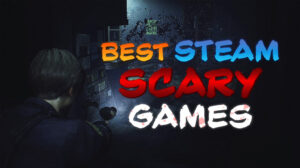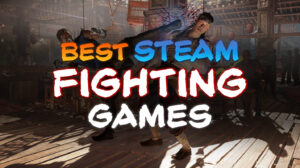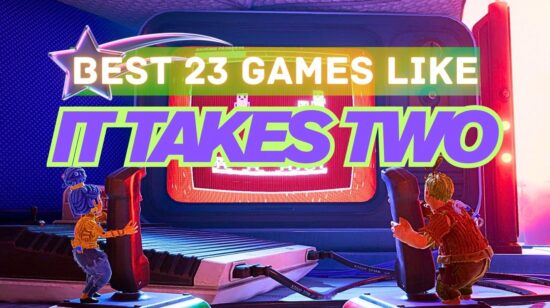Sekiro vs Ghost of Tsushima: Epic Showdown of Samurai Action Games
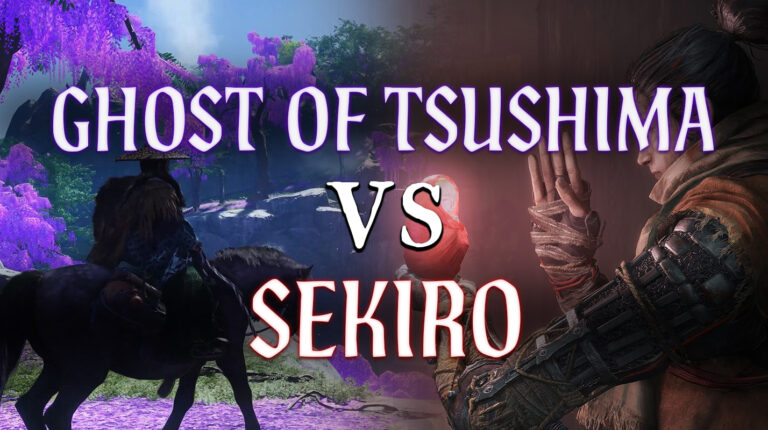
Sekiro vs Ghost of Tsushima is a debate that sparks passion in every samurai-loving gamer I know. Both are set in beautiful, war-torn Japan… but that’s where the similarities end. One is a brutal test of patience and precision. The other is a cinematic, open-world ride packed with emotion, stealth, and sweeping landscapes. So which one should you play first? That’s exactly what we’re here to figure out.
Maybe you love the thrill of punishing boss fights and skill-based combat (hi, Sekiro fans), or maybe you prefer exploring a story-driven world at your own pace (looking at you, Ghost fans). Either way, both games offer wildly different takes on honor, combat, and the way of the warrior.
In this comparison, we’ll break it all down, including the combat, world design, stealth, narrative, and overall player experience, so you can decide which adventure fits your style best.
Jump to:
Sekiro vs Ghost of Tsushima: Combat System
| Sekiro: Shadows Die Twice | Ghost of Tsushima | |
|---|---|---|
| Combat Style | Precision-based duels, posture-breaking, and perfect parries. | Dynamic stance-based swordplay with combos and cinematic finishers. |
| Difficulty | Extremely challenging, making Sekiro stand out among the very best Soulslike games. | Balanced and adaptable, which is why it often tops lists of the most engaging games like Ghost of Tsushima. |
| Player Freedom | Linear but incredibly rewarding for mastery. | Open-world design with stealth, gadgets, and flexible playstyles. |
| Abilities & Tools | Shinobi prosthetics, stealth mechanics, and grappling hook add unique combat depth. | Ghost weapons, stance changes, and stealth assassination techniques expand tactical options. |
What players say
Sekiro: Shadows Die Twice
Ghost of Tsushima
Sekiro: Shadows Die Twice

| Our Score | 9.5
☆
★
☆
★
☆
★
☆
★
☆
★
☆
★
☆
★
☆
★
☆
★
☆
★
|
| Platforms | PlayStation, Xbox, PC |
| Year of Release | 2019 |
| Developer | FromSoftware |
Sekiro: Shadows Die Twice is not for the faint of heart. This is a game where combat is a high-stakes duel, and you’re always one mistake away from death.
Here’s what defines its gameplay:
- Parry is king – timing your deflects is crucial for survival.
- Posture over HP – break an enemy’s stance to land a deathblow.
- Aggression rewarded – defense is important, but pressing forward is often the key to victory.
- One-on-one duels – most encounters feel like intense, personal battles.
- Minimal build variety – no RPG stats or character classes to tweak; you are the build.
It’s more of an action game than a traditional RPG, with laser focus on tight, reactive swordplay. If you’re exploring action-heavy titles with RPG depth but want something that leans heavily into skill-based combat, Sekiro stands apart.
Gamers who thrive on precision, discipline, and punishing difficulty will find Sekiro unforgettable.
Ghost of Tsushima
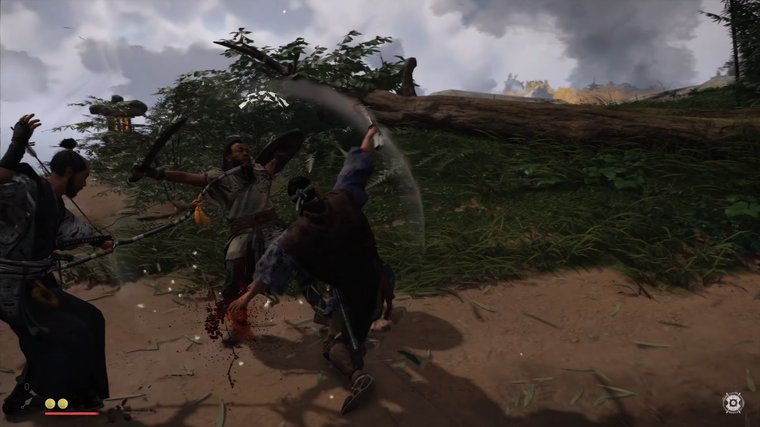
| Our Score | 9.2
☆
★
☆
★
☆
★
☆
★
☆
★
☆
★
☆
★
☆
★
☆
★
☆
★
|
| Platforms | PlayStation 4, PlayStation 5, PC |
| Year of Release | 2020 (Director’s Cut: 2021) |
| Developer | Sucker Punch Productions |
Few games strike a balance between style, story, and freedom quite like Ghost of Tsushima. Set during the Mongol invasion of Tsushima Island, you play as Jin Sakai, a samurai warrior torn between upholding traditional honor and embracing unconventional methods to save his homeland.
Use Guiding Wind to mark hidden collectibles on your map, like hot springs and haiku spots. It’s a subtle way to boost your stats and unlock immersive side content without breaking the story flow.
Combat is fast, fluid, and rewarding:
- Master four distinct combat stances, each tailored to counter a different weapon type
- Timing-focused mechanics like parries and dodges give fights a crisp, reactive feel
- Ghost tactics introduce stealth mechanics such as silent assassinations, kunai throws, and smoke bombs
- Switching between open combat and stealth is smooth and intuitive
- Jin’s progression system includes skill trees, armor sets, and charms that enhance specific playstyles
The game truly shines in how it respects your choices. You can walk through the front gates, challenge enemies to a standoff, and fight with honor. Or you can use the shadows, strike unseen, and dismantle your foes quietly. There is no forced path, so the game adapts to the way you prefer to play.
Visually, it is breathtaking. Fields of pampas grass sway in the wind, foxes guide you to hidden shrines, and the environment feels alive. If you’re playing on PC, one of the best gaming laptops will elevate this experience even further. Console players will find it remains one of the best PS5 games to own.
Ideal for players who enjoy cinematic swordplay and the freedom to approach each battle in their own way, whether as a traditional samurai or a strategic Ghost.
Sekiro vs Ghost of Tsushima: World Design and Exploration
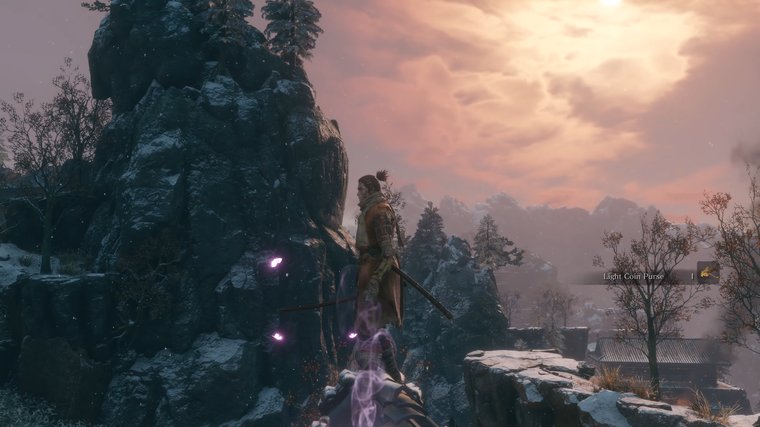
When it comes to world design, Sekiro and Ghost of Tsushima are both set in feudal Japan, but the way they invite you into their worlds couldn’t be more different.
Sekiro: Tight, Tactical, and Layered
Sekiro isn’t interested in being a traditional open world. Instead, it offers a carefully sculpted, interconnected map that encourages exploration through:
- Grappling to rooftops or scaling temple walls gives you a true shinobi experience
- FromSoftware packs its maps with tucked-away items, minibosses, and alternate routes
- Rather than endless terrain, each area loops into the next, rewarding curiosity and memory
It’s a masterclass in level design, where the environment is just as much a puzzle as the enemies you face.
Also, if you are looking for more immersive and challenging titles like Sekiro, check out our picks for the top soulslike games that reward the bold and observant.
Ghost of Tsushima: A Living, Breathing Open World
Ghost of Tsushima flips the script with an expansive open world drenched in color, wind, and emotion. It’s cleverly designed:
- Guiding wind and animals replace traditional waypoints, encouraging you to look at the environment, not your map
- Dynamic side activities like haiku spots, bamboo strikes, fox dens, and hot springs give every inch of the island purpose
- Multiple biomes across Tsushima Island offer shifting visuals and moods, from golden forests to frozen mountain tops
It’s no surprise this game shows up on lists of the biggest video game maps that are as satisfying to explore as they are to look at.
Unlike Sekiro’s tight corridors, Ghost’s open world lets you play at your own pace. Want to charge into Mongol camps on horseback? Go for it. Prefer to sneak through the tall grass and strike from the shadows? That works too. It’s that freedom of approach that makes exploration feel so personal.
And if you’re looking to take your exploration online with friends, explore our picks for the best multiplayer games to expand your world even more.
Winner: Ghost of Tsushima
Sekiro has a tight, well-designed world full of clever paths and hidden challenges, which is great for careful players. But Ghost of Tsushima gives a huge, open world where you can explore freely, ride horses, find secrets, and do side quests. It feels alive and lets you play the way you want, so it wins for world design and exploration.
Sekiro vs Ghost of Tsushima: Story
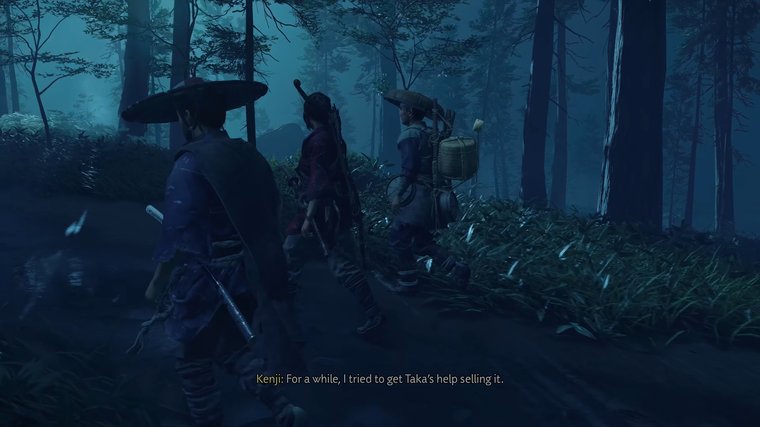
While both Sekiro and Ghost of Tsushima feature samurai protagonists and deep personal journeys, their storytelling approaches couldn’t be more different. One leans heavily into cryptic lore and individual redemption, while the other delivers a sweeping, emotional cinematic tale. Let’s break it down.
Sekiro: Shadows Die Twice
- Sekiro takes a more minimalist, FromSoftware-style approach to storytelling. The narrative centers around Wolf, a loyal shinobi on a mission to rescue his kidnapped lord and fulfill his oath.
- The story is linear and focused, but most of the deeper lore is hidden in environmental clues, cryptic NPC dialogue, and item descriptions, similar to the Dark Souls series. (If you’re a fan of layered, indirect storytelling, check out our picks for the best Dark Souls game.)
- It’s less about flashy cutscenes and more about discovery. You piece together the rich mythology yourself, often during quiet moments between brutal boss fights.
Ghost of Tsushima
- On the other hand, Ghost of Tsushima offers a more cinematic, story-driven experience that follows Jin Sakai’s transformation from noble samurai to stealthy “Ghost.”
- The game presents a traditional narrative arc, complete with well-acted cutscenes, side quests that build character depth, and cultural themes rooted in honor, sacrifice, and identity.
- You’re guided through clearly structured quests, and every named NPC has voiced dialogue, giving the world a living, breathing feel. For those who love immersive single-player experiences, it easily earns a spot among the best single-player games.
Both games also feature iconic weapons, Sekiro’s prosthetic tools, and Ghost’s katana combos that reinforce their story themes. (For more on unforgettable gear, don’t miss the most iconic video game weapons.)
Winner: Ghost of Tsushima
Sekiro has a story hidden in the world and small clues, which is cool if you like figuring things out yourself. Ghost of Tsushima tells a big, emotional story with cutscenes, side quests, and strong characters. It’s easier to follow and more dramatic, so it wins for story.
Sekiro vs Ghost of Tsushima: Stealth Mechanics
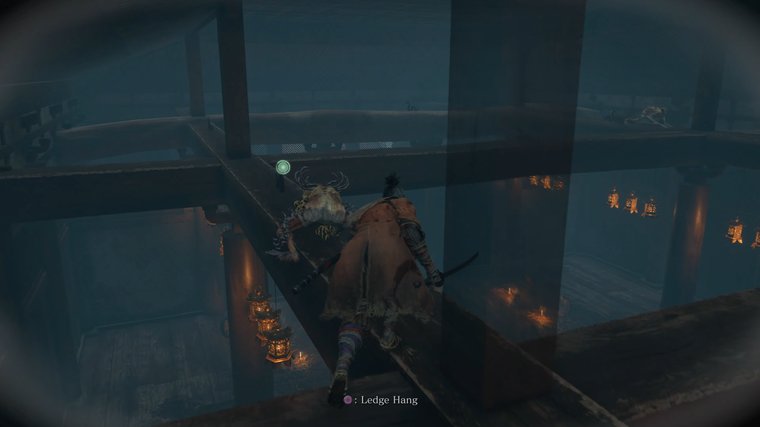
Stealth plays a role in both Sekiro: Shadows Die Twice and Ghost of Tsushima, but the way each game approaches it couldn’t be more different.
Sekiro: A Tactical Advantage, Not a Lifestyle
In Sekiro, stealth is more of a tool than a playstyle. It lets you control the start of a fight or skip it entirely.
- You can perch above enemies, eavesdrop on their chatter, and then leap down for an instant deathblow.
- Weak enemies can be picked off one by one, giving you the upper hand before tougher foes show up.
However, stealth isn’t always reliable. Eventually, you’ll be forced into direct combat, especially during boss fights that demand fast reflexes and perfect parries.
This aligns with Sekiro’s DNA as a FromSoftware title: gritty, punishing, and unrelenting, much like other entries from the studio featured in our Best Dark Souls Games roundup.
Ghost of Tsushima: Stealth as a Moral and Strategic Choice
In Ghost of Tsushima, stealth is a core pillar of gameplay and a reflection of your character’s internal conflict. As Jin Sakai, you’re a samurai trained for honorable combat, but the Mongol invasion forces you to embrace the shadowy tactics of the Ghost.
- You’re encouraged to sneak into enemy camps, use distraction tools like wind chimes, and silently take out targets with kunai, smoke bombs, and chain assassinations.
- The game rewards stealthy players with smooth animations and tension-filled sequences that feel straight out of a samurai movie.
And thanks to its gorgeous visuals and smooth mechanics, playing stealthily feels rewarding, not tedious. If you want the full experience, consider playing on a display from the Best Gaming Monitor list to take in every leaf, shadow, and sword glint. If you’re a fan of stealth-action hybrids like those featured in our Best Xbox One Games guide, Tsushima will feel right at home in your collection.
Winner: Ghost of Tsushima
Sekiro lets you use stealth sometimes, but most fights force you to go head-on. Ghost of Tsushima makes stealth a big part of the game, letting you sneak, use gadgets, and plan attacks your way. It’s easier to use and feels more fun, so it wins for stealth.
Sekiro vs Ghost of Tsushima: Progression & Customization
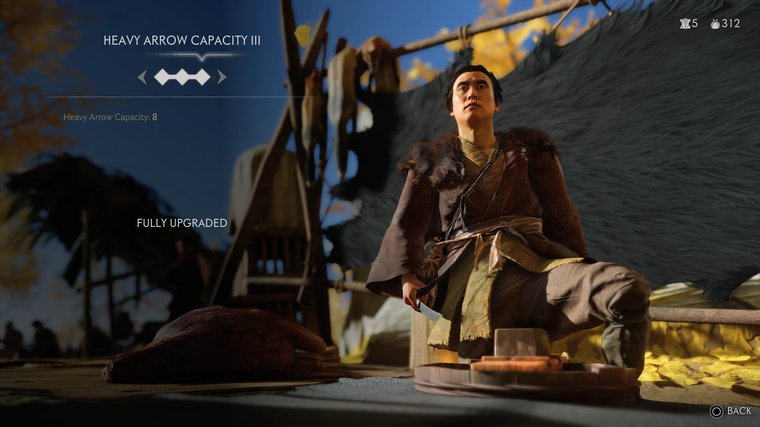
While both titles offer satisfying progression, the way they approach growth and customization is quite different.
Sekiro: Shadows Die Twice sticks to a focused and disciplined system. Instead of stat-based builds or gear swaps, Sekiro emphasizes skill mastery and tactical upgrades.
- Progression is tied to boss victories, which increase your attack power and vitality
- You unlock abilities via five skill trees:
- Shinobi Arts – focuses on core combat moves and stealth techniques.
- Prosthetic Arts – upgrades and special moves tied to your shinobi prosthetic.
- Ashina Arts – powerful samurai-style techniques.
- Senpou Arts – monk-inspired moves, emphasizing balance and defense.
- Mushin Arts – unlocked later in the game, expands certain skills into advanced versions.
- Very limited customization, no armor sets or stat tweaking
- Ideal for fans of pure action and challenge, much like the titles listed among the greatest fighting games
In contrast, Ghost of Tsushima embraces player freedom and RPG-style progression. You’re encouraged to shape Jin’s journey through skill choice and gear.
- Skill trees are divided by playstyle:
- Samurai for direct combat
- Ghost for stealth tactics
- Exploration for open-world perks
- Multiple armor sets provide unique buffs and can be swapped depending on your approach
- Cosmetic options let you dye outfits, change masks, and personalize gear without impacting stats
If you’re a fan of flexibility and stealthy gameplay, this title feels right at home with the best stealth games. And to truly appreciate the visual beauty and smooth performance of either title, consider playing on one of the best gaming PCs.
Winner: Ghost of Tsushima
Sekiro is all about skill and practice, but you can’t change much about your character. Ghost of Tsushima lets you pick skills, change armor, and make Jin your own, so it’s better for progression and customization.
Final Verdict
After spending hours with both games, here’s the honest truth: Sekiro and Ghost of Tsushima are both masterpieces, but they serve very different cravings.
Why Sekiro wins if you want raw challenge and depth
- Every fight is a test of skill, not stats
- It demands patience, precision, and absolute mastery
- There’s no hand-holding, just you, your blade, and relentless enemies
- Best for players who loved Dark Souls or Bloodborne and want something even more focused
Why Ghost of Tsushima wins if you want freedom and cinematic storytelling
- Massive open world filled with emotional side quests and visual poetry
- Customization lets you fight how you want
- Easier learning curve and more forgiving difficulty
- Ideal for players who enjoy Assassin’s Creed or The Witcher 3
So, which is better?
For me, Sekiro edges it out. The intensity of its combat, the satisfaction of beating a boss after 15 tries, and the tight, no-fluff design make it unforgettable. It doesn’t just improve your reaction speed, but also transforms how you play action games.
But if you’re in the mood for something more relaxed, beautifully crafted, and full of emotional weight, Ghost of Tsushima is the better pick.
In the end, both titles elevate the action-adventure genre in their own way.
FAQs
Which is better, Sekiro or Ghost of Tsushima?
It depends on what you value. Sekiro offers tighter combat mechanics and intense one-on-one boss fights, while Ghost of Tsushima delivers a more cinematic open-world action game with interesting characters, side quests, and a rich story.
Both are great games in their own right.
Is Ghost of Tsushima harder than Sekiro?
No, Ghost of Tsushima is more forgiving. While it offers satisfying combat, Sekiro: Shadows Die Twice demands near-perfect reactions to survive relentless enemy attacks and difficult boss fights.
You’ll need patience and skill to stay alive when you face each challenge in Sekiro.
Is Sekiro the hardest game ever?
Sekiro isn’t the hardest game ever, but it’s close. Many game designers say Sekiro is tougher than Dark Souls or Elden Ring due to its strict timing-based combat mechanics, aggressive enemies, and no way to grind for easier progress.
If you prefer Sekiro, you likely enjoy intense boss encounters.
What game inspired Ghost of Tsushima?
Ghost of Tsushima draws from samurai cinema, Red Dead Redemption, and classic open-world titles.
Its smooth gameplay, cinematic feel, and immersive side quests make it a beautiful game and a favorite game for many who love playing Ghost over other games.
What game is Sekiro similar to?
Sekiro is most similar to Dark Souls, but more focused. It emphasizes combat, enemy attacks, and one-on-one duels over RPG mechanics.
Unlike most open-world games, it’s linear and skill-based. Still, both games are worth playing for combat fans who enjoy a challenge.


